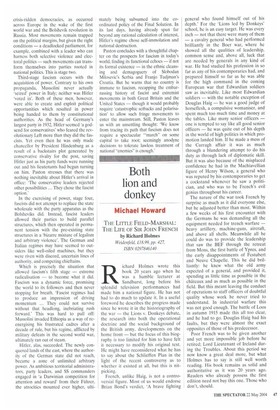The five stages of a downhill descent
Ian Garrick Mason
THE ANATOMY OF FASCISM by Robert 0. Paxton Allen Lane, £20, pp. 321, ISBN 0713997206 After defeating two fascist powers in a world war, the citizens of the democratic West have gradually come to throw the label 'fascist' around with abandon. Police officers are fascists to the protesters they confront. University administrators are fascists to the students they discipline. Think back: many of you probably had parents who were fascists — at least with regard to your curfew. Alas, the term has come to be used rather freely even in political discourse: to the Left, postwar non-communist dictatorships under generals Franco and Pinochet were fascist, and to today's pro-war Right, Muslim fundamentalists are Islamofascists', in Christopher Hitchens' colourful phrase.
Since we seem so fond of the term, it would be nice to know exactly what fascism is. Robert 0. Paxton, Professor Emeritus of Social Sciences at Columbia University and the respected author of books on Vichy France and European history, addresses this very question in The Anatomy of Fascism. Yet despite fascism's status as 'the major political innovation of the 20th century', Paxton hesitates from the outset to simply hand over a definition. Unlike the other big 'isms' — communism, liberalism, and conservatism — fascism is not really an ideology, at least in the formal sense. Its foundation is, rather, a set of 'mobilising passions' about the beauty of violence, the primacy of the group, victimisation by internal and external enemies, and the right to dominate others. Or, as Mussolini succinctly explained a few months before becoming prime minister, 'The democrats of II Mondo want to know our programme? It is to break the bones of the democrats of Ii Mondo. And the sooner the better.'
Paxton argues that it's therefore more productive to try to understand fascism as a process, rather than as a set of ideas — though he is careful to describe the intellectual and cultural climate of the late 19th and early 20th century, the anti-liberal aspects of which 'made it possible to imagine fascism'. He divides the fascist process into five stages. Stage one is the growth of fascist movements in the fertile soil of crisis-ridden democracies, as occurred across Europe in the wake of the first world war and the Bolshevik revolution in Russia. Most movements remain trapped on the political margins, but given the right conditions — a deadlocked parliament, for example, combined with a leader who can harness both selective violence and electoral politics — such movements can transform themselves into parties rooted in national politics. This is stage two.
Third-stage fascism occurs with the acquisition of power. Contrary to his own propaganda, Mussolini never actually 'seized' power in Italy; neither was Hitler 'voted in'. Both of these men, however, were able to create and exploit political opportunities which resulted in power being handed to them by constitutional authorities. As the head of Germany's largest party in 1932, Hitler seemed 'a godsend for conservatives' who feared the revolutionary Left more than they did the fascists. Yet even then he was only made chancellor by President Hindenburg as a result of a backstairs plot generated by conservative rivalry for the post, saving Hitler just as his party funds were running out and his lieutenants had begun turning on him. Paxton stresses that there was nothing inevitable about Hitler's arrival in office: The conservative leaders rejected other possibilities ... They chose the fascist option.'
In the exercising of power, stage four, fascists did not attempt to replace the state wholesale with the party apparatus as the Bolsheviks did. Instead, fascist leaders allowed their parties to build parallel structures, which then operated in permanent tension with the pre-existing state structures in a 'bizarre mixture of legalism and arbitrary violence'. The German and Italian regimes may have seemed to outsiders like well-oiled machines, but they were riven with discord, uncertain lines of authority, and competing chieftains.
Which is precisely the situation that allowed fascism's fifth stage — extreme radicalisation — to become what it did. Fascism was a dynamic force, promising the world to its followers and then never stopping for breath. 'Fascist regimes had to produce an impression of driving momentum ... They could not survive without that headlong, inebriating rush forward.' This was hard to pull off: Mussolini invaded Ethiopia as a way of reenergising his frustrated cadres after a decade of rule, but his regime, afflicted by military defeats in the second world war, ultimately ran out of steam.
Hitler, alas, succeeded. The newly conquered lands of the east, where the authority of the German state did not reach, became a zone of unlimited arbitrary power. As ambitious territorial administrators, party leaders, and SS commanders engaged in 'a Darwinian competition for attention and reward' from their Fiihrer, the atrocities mounted ever higher, ulti
mately being subsumed into the coordinated policy of the Final Solution. In its last days, having already spun far beyond any rational calculation of interest, Hitler's regime chose self-immolation and national destruction.
Paxton concludes with a thoughtful chapter on the prospects for fascism in today's world, finding its functional echoes — if not its formal existence — in the ethnic cleansing and demagoguery of Slobodan Milosevic's Serbia and Franjo Tudjman's Croatia. But he warns that no country is immune to fascism, recapping the embarrassing history of fascist and extremist movements in both Great Britain and the United States — though it would probably require 'catastrophic setbacks and polarisation' to allow such fringe movements to enter the mainstream. Still, Paxton leaves us with an unsettling thought: 'We know from tracing its path that fascism does not require a spectacular —march" on some capital to take root; seemingly anodyne decisions to tolerate lawless treatment of national "enemies" is enough.'



















































































 Previous page
Previous page